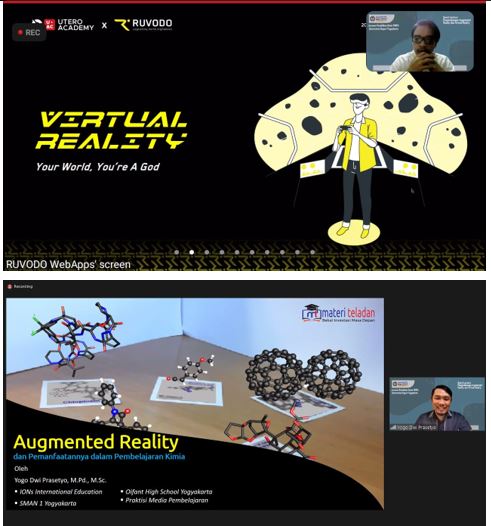 Bahasa Indonesia
Bahasa Indonesia English
English
You are here
Learn with Practitioner #1: Chemistry Learning Media

As a realization of the implementation of the Merdeka Belajar – Kampus Merdeka curriculum, the Chemistry Education Study Program as part of the Faculty of Mathematics and Natural Sciences, Universitas Negeri Yogyakarta, implements the Teaching Practitioner program. Attended by 84 students of Bachelor and Masters in Chemistry Education, Dr. Antuni Wiyarsi, M.Sc as the Coordinator of the Chemistry Education Study Program opened this Learn with Practitioner #1 Program. The theme raised is Augmented and Virtual Reality as Media in Chemistry Learning.
The first speaker was Afaf Mustofa Pratama Putra, S.Kom, M.T Founder and Creative Operation Ruvodo WebApps Malang Indonesia. Through Virtual Reality material, Afaf Pratama said that VR media can show complex molecules as in three-dimensional space. As a user, complex molecules can be physically manipulated to learn more. One of the programs that has been developed by Afaf Pratama is Virtual Reality for the concept of the Periodic System of Elements (VR-SPU). In practice, this VR-SPU can show a real picture of atomic arrangement and electron configuration so that students can actively participate in learning activities and give a real impression of abstract concepts.
Agree with what Afaf Pratama said, the second speaker proposed Augmented Reality (AR) to show abstract chemical concepts. The material about Augmented Reality was delivered by alumni of the Department of Chemistry Education, Yogo Dwi Prasetyo, M.Pd., M.Sc as a Learning Media Practitioner at several International Schools in Yogyakarta Indonesia. Augmented Reality, developed as an overlay of information or digitizing the real world with the aim of providing students as learning subjects through a more real perspective. Real views are presented digitally with the help of a camera and content-oriented books or cards. For example, to show chemical bonds that are invisible to the human eye, can be observed through the AR support so that the reality of the perception of how chemical bonds are formed. In practice, AR is implemented using a cellphone camera that is directed at a two-dimensional image of a molecule on paper that has been made with certain techniques, such as unity, so the cellphone room will display a three-dimensional display of the appropriate molecular image.
Ready-made applications for Virtual Reality and Augmented Reality are widely available on digital platforms. However, as an academic, it would be better if you develop your own media so that the media fits your learning needs. The Learn with Practitioner #1 Program Program that has been implemented hopefully can be a motivation to continue to develop oneself in accordance with the development of science and technology.
Sistem Informasi
Kontak Kami
Program Studi Pendidikan Kimia
FMIPA Universitas Negeri Yogyakarta
Gedung Dekanat D.07 FMIPA UNY
Kampus Karangmalang Yogyakarta 55281
Telp. (0274)586168 Pes. 115
Email: pend_kimia@uny.ac.id
Copyright © 2025,
